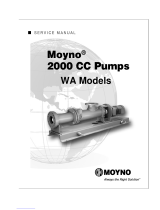
Packing Adjustment (Packing Models Only).
Packing gland attaching nuts should be evenly adjusted so
they are little more than finger tight. Over-tightening of the
packing gland may result in premature packing failure and
possible damage to the shaft and gland.
When the packing is new, frequent minor adjustments
are recommended for the first few hours of operation in
order to compress and seat the packing. Be sure to allow
slight leakage for lubrication of packing.
When excessive leakage can no longer be regulated by
tightening the gland nuts, remove and replace the packings
in accordance with the DISASSEMBLY and REASSEMBLY
instructions. The entire pump need not be disassembled to
replace the packings.
Bearing Lubrication. The prelubricated, fully sealed
bearings do not require additional lubrication.
PUMP DISASSEMBLY
WARNING: Before disassembling pump, disconnect
power source and thoroughly bleed
pressure from system. Failure to do so
could result in electric shock or serious
bodily harm.
To Disassemble Mechanical Seal Models:
1. Disconnect suction and discharge piping.
2. Remove screws (112) holding suction housing (2) to
pump body (1). Remove suction housing and stator (21).
3. Remove rotor (22) from flexible joint (24) by turning
counter-clockwise (RH thread). Use 3/16 inch diameter
punch to remove rotor pin (45) on Model 36701.
4. Flexible joint (24) can be removed from shaft (26) by
using a 3/16 inch allen wrench in end of joint (1/4 inch
wrench on 356 Models) and turn counter-clockwise. Use
3/16 inch diameter punch to remove shaft pin (46) on
Model 36701.
5. Carefully slide mechanical seal (69) off shaft (26).
Carefully pry seal seat out of pump body (1). If any parts
of mechanical seal are worn or broken, the complete
seal assembly should be replaced. Seal components are
matched parts and are not interchangeable.
6. The bearings (29) and shaft (26) assembly can be
removed from pump body (1) after snap ring (66) has
been removed. To remove the assembly, lightly tap the
shaft at threaded end using a block of wood to protect
the threads. The bearings may be pressed off the shaft.
To Disassemble Packing Models:
1. Disconnect suction and discharge piping.
2. Remove screws (112) which hold suction housing (2) to
pump body (1). Remove suction housing and stator (21).
3. Remove rotor (22) from flexible joint (24) by turning in a
counter-clockwise direction (RH thread).
4. Flexible joint (24) can be removed by using a 3/16 inch
allen wrench in end of joint (1/4 inch wrench on 356
Models) and turn in a counter-clockwise direction.
5. The packing (42) can be removed without removing the
shaft (26) using the following procedure:
a. Remove gland bolts (47).
b. Slide gland (41) away from packing (42).
c. Pull out packing (42) (and lantern ring halves (57) on
356 Models) using a packing removing tool.
Note:Packing can be removed after shaft has been re-
moved by pushing out from pump side of pump body
after gland (41) has been detached.
6. The bearings (29) and shaft (26) assembly can be
removed from pump body (1) after snap ring (66) has
been removed. To remove the assembly, lightly tap the
shaft at threaded end using a block of wood to protect the
threads.
7. To disassemble shaft assembly, remove snap ring (66A)
from shaft (26) and press bearings (29) and bearing
spacer (33) off the shaft.
PUMP ASSEMBLY
To Assemble Mechanical Seal Models:
1. Press bearings (29) on shaft (26), and locate slinger ring
(77) near bearing on threaded end of shaft.
Note: When replacing bearings, always press on the inner
race when assembling to shaft, and on the outer race
when pressing bearings into the housings.
2. Press shaft assembly into pump body (1) securing with
snap ring (66).
3. Install mechanical seal (69) using the following
procedure:
a. Clean and oil sealing faces using a clean light oil (not
grease).
Caution: Do not use oil on EPDM parts. Substitute
glycerin or soap and water.
b. Oil the outer surface of the seal seat, and push the
assembly into the bore in the pump body (1), seating
it firmly and squarely.
c. After cleaning and oiling the shaft, slide the seal body
along the shaft until it meets the seal seat.
d. Install seal spring and spring retainer on shaft.
4. Thread flexible joint (24) into shaft (26) in a clockwise
direction (RH thread). On 356 Models, install seal spacer
(69A) and washer (116) before threading flexible joint
onto shaft in a clockwise direction. On Model 36701, use
shaft pin (46) to pin flexible joint (24) to shaft.
5. Thread rotor (22) onto flexible joint (24) in a clockwise
direction (RH thread). On Model 36701, pin rotor (22) to
joint using rotor pin (45).
6. Slide stator (21) on rotor (22). On 331 and 332 Models,
insert rounded end of stator ring (135) into end of stator
prior to installing stator on rotor.
7. Secure stator (21) and suction housing (2), with suction
port vertically up, to pump body (1) using screws (112).
8. Proceed as in installation instructions.
To Assemble Packing Models:
1. Press bearings (29), with bearing spacer (33) in between,
on shaft (26) and secure in place using snap ring (66A).
Note: When replacing bearings, always press on the inner
race when assembling to shaft, and on the outer race
when pressing bearings into the housings.
Page 3


























